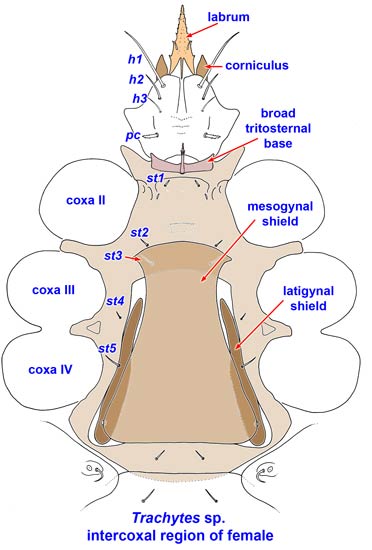Taxonomic Position
Cohort Uropodina
Subcohort Uropodiae
Polyaspidoidea Berlese
Trachytidae Trägårdh
Trachytes Michael
Diagnostic characters:
-
Slow moving, rough surfaced wedge-shaped mites with a dense coating of cerotegument; podonotal, marginal, and pygidial shields under cerotegument
-
<100 dorsal idiosomal setae
-
Scabellum and pedofossae absent
-
Sternal setae (st1-4) + JV1 on ventral shield that encompasses the genital opening; st5 on narrow latigynal shields
-
Mesogynal shield nude, shaped like an elongate trapezoid
-
Anal opening on ventrianal shield.
-
Legs I without ambulacra, coxae I enlarged, but subcylindrical and widely separated; trochanter I with 4 setae; tibia I with 4 dorsal and 2 ventral setae; all genua with 4 dorsal setae; genu II with 4 lateral setae
-
Chelicerae slender, elongate; fixed digit ending in tapering, acuminate process; corniculi horn-like
-
Tectum with strong, tapering median process; hypostomal denticles in broad median rows
-
Palp apotele 2-tined; palp genu with 5 setae, palp femur with 5 setae
-
Tritosternal laciniae fused basally and subdivided distally; tritosternum wider than long, rectangular
-
Male genital opening intercoxal, valves with or without setae; chelicerae not obviously modified for sperm transfer

Similar taxa.
Key to adult females of common genera of Polyaspidoidea
1. Idiosoma and mesogynal shield oval to subrectangular; marginal shield fragmented - 2
- Idiosoma pyriform, mesogynal shield trapezoidal; marginal shield entire - Trachytes
2. Genu IV with two ventral setae - 3
- Genu IV with one ventral seta - Polyaspinus (+ Uroseius)
3. Chelicerae and corniculi elongate, the latter reaching distal end of palpgenu - Polyaspis (+ Dyscritaspis)
- Chelicerae and corniculi not elongate - Dipolyaspis
Ecology. Species of Polyaspis are ambush predators, but the ecology of other Polyaspidoidea is poorly known. Many species are present in forest litter or associated with rotting wood.
References
Ainscough,
BD. 1981. Uropodine studies. I. Suprageneric classification in the cohort
Uropodina Kramer, 1882 (Acari: Mesostigmata).
International Journal of Acarology 7:47-56.
Bloszyk,
J & Halliday, RB. 2000. Observations on the genus Polyaspinus
Berlese 1916 (Acari: Trachytidae). Systematic
& Applied Acarology 5: 47-64.
Camin,
JH. 1954. A new species of uropodine
mite, Polyaspinus higgensi (Mesostigmata: Trachytoidea: Trachytidae). Bulletin of the Chicago Academy of Sciences 10: 35-41.
Evans
EO and Till WM. 1979. Mesostigmatic mites of Britain and Ireland
(Chelicerata: Acari-Parasitiformes). An
introduction to their external morphology and classification. Transactions of the Zoological Society of
London 35 (2): 145-270.
Gilyarov MS & Bregatova NG (eds). 1977. Handbook for the Identification of Soil-inhabiting Mites, Mesostigmata. Zoological Institute of the Academy of Sciences: Petrograd [In Russian]
Karg W. 1989. Acari (Acarina), Milben Unterordnung Parasitiformes (Anactinotrichaeta) Uropodina Kramer, Schildkrötenmilben. Die Tierwelt Deutschlands 67: 1-203.
Krantz, GW & Ainscough, B. 1990. Mesostigmata. pp. 583-665, in DL Dindal (ed) Soil Biology Guide. John Wiley & Sons: Brisbane.
Wisniewski, J. and W. Hirschmann 1993. Katalog der Ganggattungen, Untergattungen, Gruppen und Arten die Uropodiden der Erde. Gangsyst. Parasitiformes, Schriften. für vergleich. Milbenkunde Folge 40: 466pp. Hirschmann Verlag, Nürnberg.
Womersley,
H. 1961. Studies of the Acarina fauna of leaf-litter and moss from
Australia. No. 2. A new trachytid mite,
Polyaspinus tuberculatus, from Queensland (Acarina, Trachytina). Records of the South Australian Museum
14: 115-123.